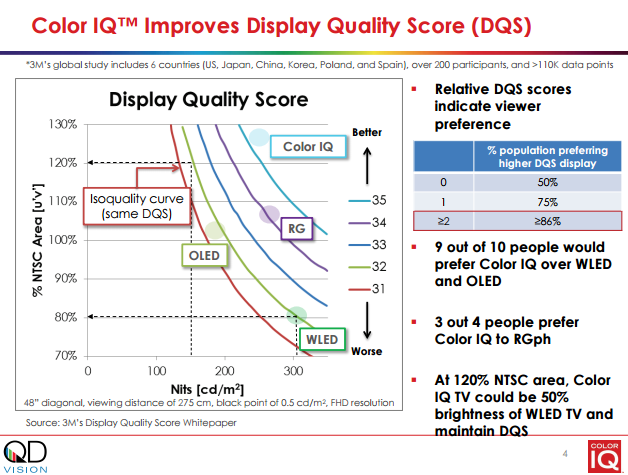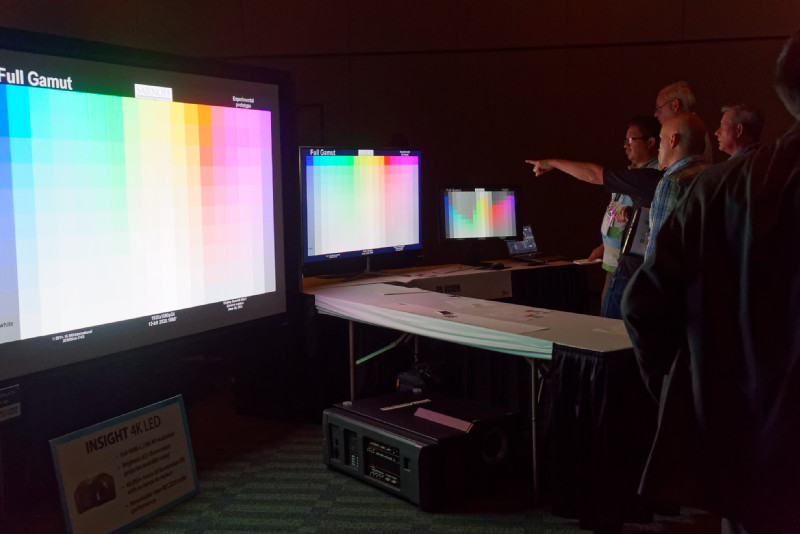 The second panel session was on the topic of wide colour gamut (WCG) and the panel comprised:
The second panel session was on the topic of wide colour gamut (WCG) and the panel comprised:
- Dr John Ho – from QD Vision
- Norm Hurst responsible for developing test patterns for SRI
- Josef Marc is from Archimedia and he is working on next generation media services
- Sander Phipps is from Sony where he is involved with professional products
- Phil Laney is from Digital Projection
The first question was about the use of L*a*b* as proposed by Sharma on the first day and Ho said that while it is a good system, most display engineers really don’t have a good understanding of the science behind colour. So even if using it was correct, it would be hard to switch directly to Lab and it may not even be the best system. 3M has done a lot of work in this area, but has not been able to truly get consistent results between subjective results and the measurements. Laney said that Lab is more consistent than Yxy in his experience.
Later in the discussion, Ho showed some work he has done at QD Vision, to use the data from the 3M Display Quality Score (DQS) research which he sees as showing that quantum dot (QD) and even LCD displays with RG LEDs will be better appreciated for colour than OLEDs.

Marc said that as a supplier of professional media players, he would always like to know how to deliver the “artistic intent”. Hurst said that he made tests for the conference in Yxy even though he understood that this made the colour charts less linear. He made charts that showed steps from the standard Rec. 709 gamut to map out to Rec. 2020 so that this could be viewed on the systems at the event.
Hurst said that new buyers of hifi “crank up the bass and treble” but, over time, they gradually migrate back to flat controls and he thinks the same applies to colour. New systems with WCG will encourage the development of very bright colours, but they will then go back to more natural colours.
At the event, there was a practical comparison of three different projectors and attendees were asked to rate them. The results showed that the sRGB (BenQ) colour projector beat the non-SRGB DLP projector and the lowest score on colour accuracy and quality went to the LCD projector.
There was a substantial discussion about what colour accuracy really means. Ho said that if you want wide gamut, you have to have narrow primaries. Beck of Barco disagreed with this (from the floor) – he said you can use a range of blue and still get a very wide gamut. There was some discussion of the possibilities of using more than three primaries to develop wider gamuts. As with lasers, there are questions of how you generate particular colours using four primaries that can lead to issues of metamerisms. While there was a view that “nobody is really developing multi-primary”.
There are comments sometimes when showing WCG content, to the effect “why is the yellow dull?”. Ho said that this is to do with whether the red and green interact and depends on the filters.
Hurst then explained how he created the test patterns used. He had one problem because he missed that in video, black is 16 while it is 0 in graphics and white is 235 in video, but 255 in graphics. There was a discussion about the Eizo monitor that was being used in the tests. It was used as the reference and has a special circuit that can identify colours that are out of gamut, by showing them as grey.
 The demo of wide gamut at the Summit. Note the grey on the Eizo monitor for colours outside Rec. 709
The demo of wide gamut at the Summit. Note the grey on the Eizo monitor for colours outside Rec. 709
Sony is going to laser phosphor with its SXRD projectors which will get to 80% of the full Rec 2020 gamut – at least, that is the target. Sony has a new phosphor formula, especially in red – plus extra blue LEDs with a different blue. The final gamut should be close to P3 and be very similar to Sony OLED monitors so that they can be used in grading suites. For visual simulation, you need 20 hours per day usability and you need consistency and those are features of the projector. (There will be two versions as revealed in our report Sony Describes New Laser Phosphor Projector Improvements.)
Ho went through the environmental issues of QDs and as we have covered this in some detail over the last couple of weeks, we won’t repeat it here. He did say that 100ppm of cadmium is perfectly legal, without any exemptions, while QD Vision’s materials are in the range of 300-500ppm. However, we were struck by the statistic that he quoted that the cadmium in the QDVision products for 500 TVs is the equivalent of one AA nicad battery! That sets the scale very clearly.

